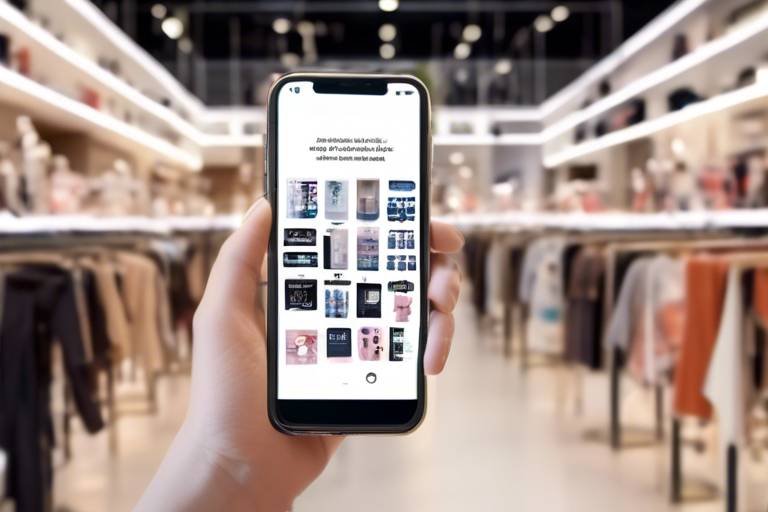How Smart Devices are Changing Consumer Habits
In today's fast-paced world, smart devices have become more than just gadgets; they are transformative tools that are reshaping our daily lives and shopping habits. From smartphones to smart speakers, these devices have revolutionized the way we interact with brands and make purchasing decisions. Imagine walking into a store and being greeted by your favorite brand's app, offering personalized discounts based on your previous purchases. This is not science fiction; it's the reality of how smart technology influences consumer behavior.
The rise of smart devices has made it easier for consumers to access information, compare prices, and make purchases with just a few taps on their screens. In fact, studies show that over 70% of consumers now use their mobile devices to aid in shopping decisions. This shift has not only changed how we shop but also what we expect from brands. Today's consumers are looking for convenience, speed, and personalization, and smart devices deliver on these expectations.
As we dive deeper into the impact of smart devices on consumer habits, we'll explore how these technologies are influencing shopping behaviors, preferences, and even the way we interact with our homes. From mobile shopping trends to the integration of smart home technologies, the landscape of consumer behavior is evolving rapidly, driven by the capabilities of smart devices. So, buckle up as we navigate this exciting journey into the future of shopping!
Smart devices have proliferated in recent years, becoming integral to daily life. The availability of these devices has skyrocketed, making them accessible to a broader audience than ever before. Whether it's a smartphone, a smartwatch, or a smart home assistant, these devices are now commonplace in households around the globe. But what does this mean for consumer habits? The answer lies in the way these devices have changed our expectations and interactions with brands.
For instance, consider how we used to shop before the advent of smart devices. Going to a store meant physically browsing through aisles, comparing prices manually, and sometimes even waiting in long lines. Now, with a few swipes on a screen, we can access an entire universe of products at our fingertips. This shift has created a culture of instant gratification, where consumers expect to find what they want, when they want it, without the hassle of traditional shopping.
Smart devices are reshaping how consumers shop, from online purchases to in-store experiences. The integration of technology into shopping has led to a significant shift in consumer patterns. For instance, many shoppers now prefer to browse online before visiting a physical store, often checking product availability and prices via their smartphones. This behavior is indicative of a larger trend: consumers are increasingly relying on technology to inform their purchasing decisions.
The convenience of mobile shopping has surged, leading to changes in consumer preferences. With the rise of e-commerce, consumers are no longer tied to their desktops; they can shop from anywhere at any time. This has led to a rise in mobile shopping apps, which offer a seamless experience for users. It's as if we now carry a virtual shopping mall in our pockets, ready to browse at a moment’s notice.
With the rise of retail apps, consumers are increasingly turning to mobile platforms for shopping. These apps are designed to be user-friendly and often include features like push notifications for sales, personalized recommendations, and easy checkout options. The appeal of these apps lies in their ability to create a tailored shopping experience that meets individual needs. For example, a shopper may receive a notification about a sale on their favorite brand, prompting an immediate purchase.
Social media platforms have become vital for promoting products. With smart devices, consumers can easily discover new brands and products through social media feeds. The integration of shopping features on platforms like Instagram and Facebook allows users to purchase products directly from their favorite posts. This phenomenon has given rise to a new form of shopping known as social commerce, where the lines between social media and shopping blur.
Smart devices enable personalized shopping experiences through data analysis. Retailers can track consumer behavior and preferences, allowing them to offer tailored recommendations that resonate with individual shoppers. This level of personalization not only enhances the shopping experience but also fosters brand loyalty. When consumers feel understood and valued, they are more likely to return for future purchases.
The integration of smart devices in homes is changing consumer habits significantly. Smart home technology, such as smart speakers and connected appliances, is not just about convenience; it also influences purchasing decisions and lifestyle choices. For example, a smart fridge that tracks inventory can suggest recipes based on available ingredients, prompting users to purchase missing items via voice commands.
Voice assistants are changing the way consumers interact with brands. The growth of voice-activated shopping is a testament to this shift. With just a simple command, users can order products, check prices, or even get product recommendations. This hands-free approach to shopping is particularly appealing to busy individuals who appreciate the efficiency that smart devices offer.
Home automation systems are not just about convenience; they also influence consumer preferences. These systems allow users to control their home environment through smart devices, leading to more informed purchasing decisions. For instance, if a smart thermostat suggests energy-efficient products, consumers are more likely to consider these options when shopping, aligning their purchases with their values and preferences.
- How do smart devices influence consumer behavior?
Smart devices provide instant access to information and personalized experiences, leading to more informed purchasing decisions. - What is social commerce?
Social commerce refers to the integration of social media and shopping, allowing users to purchase products directly through social platforms. - How does voice-activated shopping work?
Voice-activated shopping allows consumers to use voice commands to search for and purchase products through smart speakers or devices.

The Rise of Smart Devices
Smart devices have taken the world by storm, transforming our daily lives in ways we never imagined. From the moment we wake up to the sound of our smart alarms to the time we wind down with a binge-worthy show on our smart TVs, these gadgets have become integral to our routines. But what exactly is driving this surge in smart device usage? It’s not just about convenience; it’s about a shift in consumer expectations and behaviors. As technology evolves, so do we, and smart devices are at the forefront of this change.
One of the most significant factors contributing to the rise of smart devices is their increasing availability. With prices dropping and options expanding, consumers are more inclined to invest in these technologies. Whether it's a smart thermostat that learns your habits or a fitness tracker that monitors your health, these devices are designed to enhance our lives. Moreover, the seamless integration of smart devices into our homes is making them more appealing. Imagine controlling your lights, temperature, and even your coffee maker from your smartphone! It’s like having a personal assistant at your fingertips.
As we embrace these devices, we also witness a shift in consumer habits. People are becoming more tech-savvy and expect their devices to not only perform tasks but also to communicate with one another. This interconnectedness is known as the Internet of Things (IoT), and it’s revolutionizing how we interact with technology. Smart devices are no longer just standalone gadgets; they are part of a larger ecosystem that enhances our daily lives. For example, a smart fridge can notify you when you're running low on groceries, while a smart speaker can help you order them with just your voice. The possibilities are endless!
Furthermore, the rise of smart devices has led to an increased focus on data privacy and security. As consumers become more aware of how their data is being used, they are demanding greater transparency from manufacturers. This has prompted companies to prioritize security features in their devices, ensuring that users feel safe while enjoying the benefits of smart technology. In a world where data breaches are common, knowing that your smart device is secure can significantly influence purchasing decisions.
In summary, the rise of smart devices is not just a trend; it’s a fundamental shift in how we live, work, and shop. As these devices continue to evolve, they will undoubtedly shape consumer habits in ways we can’t yet foresee. The future is bright for smart technology, and we are just beginning to scratch the surface of what’s possible. Are you ready to embrace the change?

Impact on Shopping Behavior
The advent of smart devices has profoundly reshaped consumer shopping behavior, creating a paradigm shift that has left traditional retail in the dust. Imagine walking through a mall, your smartphone buzzing with notifications about exclusive deals just around the corner. This is the new reality for shoppers today, where technology and convenience intertwine seamlessly. Consumers are no longer confined to the brick-and-mortar experience; instead, they are empowered by technology that allows them to shop anytime, anywhere. The result? A significant transformation in how we perceive shopping.
One of the most notable changes is the **increased reliance on online shopping**. With just a few taps on a screen, consumers can browse thousands of products, read reviews, and make purchases without stepping foot outside their homes. This has led to a dramatic rise in e-commerce, with online sales expected to continue climbing. According to recent statistics, e-commerce sales accounted for approximately **20% of total retail sales** in 2022, and this figure is projected to rise even further. As convenience becomes paramount, consumers are gravitating toward platforms that offer a seamless shopping experience.
Moreover, smart devices have revolutionized in-store experiences as well. Retailers are leveraging technology to enhance customer engagement and streamline the shopping process. For instance, many stores now utilize **augmented reality (AR)** to allow customers to visualize products in their own space before making a purchase. Picture this: you’re in a furniture store, and instead of imagining how a couch will look in your living room, you can use your smartphone to see it in real-time. This immersive experience not only boosts consumer confidence but also encourages impulse buying.
Another significant factor is the **growing trend of mobile shopping**. With the majority of consumers owning smartphones, the convenience of shopping on-the-go has never been more appealing. People can now compare prices, read product reviews, and make purchases during their daily commutes or while waiting in line. This shift has led to the rise of mobile shopping apps, which are designed to make the purchasing process as effortless as possible. These apps often feature user-friendly interfaces, personalized recommendations, and exclusive discounts that entice consumers to make quick decisions.
Additionally, the influence of social media cannot be overstated. Platforms like Instagram and TikTok have become powerful tools for product discovery, with brands leveraging influencer marketing to reach potential customers. Smart devices enable users to interact with these platforms easily, creating a seamless transition from discovery to purchase. For example, a user might see a trendy outfit on their feed, click on it, and be directed to a retail website to buy it—all within a matter of minutes. This instant gratification is a driving force behind today’s shopping habits.
As we delve deeper into this tech-driven shopping landscape, it’s clear that the impact of smart devices extends beyond mere convenience; it’s about creating a **holistic shopping experience** that caters to the modern consumer's needs. From personalized recommendations powered by data analytics to the integration of smart home technology, the future of shopping is bright and filled with possibilities. As retailers adapt to these changes, they must prioritize understanding consumer behavior and leveraging technology to enhance the shopping journey.
- How have smart devices changed shopping habits? Smart devices have made shopping more convenient, allowing consumers to shop online and in-store seamlessly, often with the help of apps and social media.
- What role does mobile shopping play in consumer behavior? Mobile shopping has surged, enabling consumers to make purchases on-the-go, compare prices, and access exclusive deals through apps.
- How does social media influence shopping decisions? Social media platforms serve as discovery tools for products, with influencers promoting items that lead to immediate purchases via links.
- What is the future of shopping with smart devices? The future of shopping will likely focus on enhanced personalization, integration of AR, and continued growth of e-commerce and mobile platforms.

Mobile Shopping Trends
The world of shopping has dramatically shifted in recent years, and at the forefront of this transformation is the rise of mobile shopping. Imagine being able to browse your favorite stores, compare prices, and make purchases—all from the palm of your hand. This convenience has led to a surge in the popularity of mobile shopping, fundamentally altering consumer preferences and behaviors. According to recent studies, over 70% of consumers now prefer shopping via their smartphones, illustrating just how integral these devices have become to our shopping experiences.
One significant factor contributing to this trend is the ubiquity of smartphones. With nearly everyone owning a mobile device, shopping has become more accessible than ever. Consumers can shop anytime and anywhere—whether they’re lounging on the couch, commuting to work, or even waiting in line at the grocery store. This level of convenience has not only made shopping easier but has also shifted the expectations of consumers. They now demand a seamless, user-friendly experience that mobile platforms must deliver to keep them engaged.
Moreover, the mobile shopping experience is enhanced by innovative features that cater to the modern consumer's needs. For instance, many retailers have developed mobile apps that offer exclusive discounts, personalized recommendations, and easy payment options. These apps are designed to create an engaging shopping environment that encourages users to explore and make purchases. A recent survey revealed that 65% of users are more likely to shop at a retailer that offers a dedicated app, highlighting the importance of mobile optimization in today’s retail landscape.
Another compelling aspect of mobile shopping trends is the integration of social media into the shopping experience. Platforms like Instagram and Facebook have transformed into powerful marketing tools, allowing brands to showcase their products directly to consumers. With features like shoppable posts and in-app purchasing, social media has blurred the lines between browsing and buying. This has led to a new phenomenon known as “social shopping,” where consumers discover products through their social feeds and make immediate purchases—all facilitated by their mobile devices.
However, it's not just about convenience and accessibility; mobile shopping trends also emphasize the importance of personalization. Retailers leverage data analytics to tailor the shopping experience to individual preferences, making recommendations based on past purchases and browsing behavior. This level of personalization not only enhances the shopping experience but also fosters brand loyalty, as consumers feel more connected to brands that understand their needs.
In summary, mobile shopping is not just a trend; it represents a fundamental shift in consumer behavior. With the convenience of smartphones, the rise of dedicated shopping apps, the influence of social media, and the emphasis on personalization, consumers are embracing a new era of shopping that is more dynamic and engaging than ever before. As technology continues to evolve, so too will the landscape of mobile shopping, promising exciting developments for both consumers and retailers alike.
- What is mobile shopping? Mobile shopping refers to the act of purchasing goods or services through mobile devices, such as smartphones or tablets.
- How has mobile shopping changed consumer behavior? It has made shopping more convenient and accessible, allowing consumers to shop anywhere and anytime, leading to a preference for mobile platforms.
- What role does social media play in mobile shopping? Social media platforms serve as marketing tools, enabling brands to showcase products and facilitate purchases directly through their apps.
- Why is personalization important in mobile shopping? Personalization enhances the shopping experience by providing tailored recommendations, fostering brand loyalty among consumers.

App-Based Shopping
In today's fast-paced world, has emerged as a game changer for consumers and retailers alike. With just a few taps on a smartphone, shoppers can browse, compare, and purchase products from the comfort of their homes or while on the go. This convenience has led to a significant shift in how we approach shopping, making it not just easier but also more enjoyable. Imagine standing in line at a store, only to realize you can get the same item delivered to your door in a matter of hours—this is the reality that app-based shopping has created.
One of the key features that make retail apps so appealing is their user-friendly interfaces. These apps are designed with the consumer in mind, providing a seamless experience that encourages exploration and engagement. Features such as personalized recommendations, easy navigation, and fast checkout processes make shopping feel less like a chore and more like a delightful experience. For instance, many apps utilize artificial intelligence to analyze user behavior and suggest products that align with individual preferences. This means that the more you shop, the better the app gets at understanding your unique style and needs.
Moreover, app-based shopping isn't just about convenience; it's also about exclusivity. Many retailers offer app-only discounts and promotions that incentivize users to download and engage with their platforms. This creates a sense of urgency and excitement among consumers, pushing them to make purchases they might otherwise delay. Imagine scrolling through your favorite store's app and discovering a flash sale on that pair of shoes you've been eyeing—it's hard to resist the temptation!
Another fascinating aspect of app-based shopping is the integration of social features. Many retail apps now allow users to share their finds on social media or even within the app itself, creating a community of shoppers who can recommend products to one another. This social aspect not only enhances the shopping experience but also builds a sense of trust among consumers. After all, who better to rely on for product recommendations than friends and fellow shoppers?
To illustrate the impact of app-based shopping, let’s take a look at some statistics:
| Statistic | Percentage |
|---|---|
| Increase in mobile shopping in the last year | 30% |
| Consumers who prefer shopping via apps | 65% |
| Retailers offering app-exclusive discounts | 50% |
In conclusion, app-based shopping is revolutionizing the retail landscape, making it more accessible, personalized, and engaging for consumers. As technology continues to evolve, we can expect even more innovative features that will enhance the shopping experience further. So, the next time you're out and about, remember that your favorite store is just a tap away, ready to cater to your shopping desires at any moment!
- What are the advantages of app-based shopping? App-based shopping offers convenience, personalized experiences, exclusive deals, and social sharing features.
- How secure are shopping apps? Most reputable shopping apps use encryption and secure payment methods to protect user data.
- Can I return items purchased through an app? Yes, most retailers have return policies that apply to purchases made through their apps.

Social Media Influence
In today's digital landscape, social media is not just a platform for sharing cat videos or vacation photos; it has evolved into a powerful marketing tool that shapes consumer behavior in unprecedented ways. With billions of users scrolling through their feeds daily, brands have discovered that social media is a goldmine for reaching potential customers. But how exactly does this influence consumer choices? Let’s dive into the details.
First and foremost, social media platforms like Instagram, Facebook, and TikTok have become essential for product discovery. When users see a friend or influencer showcasing a product, it often feels more authentic than traditional advertising. This peer influence can trigger a desire to purchase, as people tend to trust recommendations from their social circles over conventional ads. It's akin to receiving a recommendation from a friend at a coffee shop—much more convincing than a billboard on the highway!
Moreover, social media allows brands to engage with consumers on a personal level. Through comments, likes, and shares, companies can create a sense of community around their products. This interaction fosters brand loyalty, as consumers feel valued and heard. A recent survey indicated that 70% of consumers are more likely to buy from brands they follow on social media. This statistic underscores the importance of maintaining an active presence on these platforms.
Let’s not forget about the role of user-generated content. When consumers share their experiences with a product on social media, it creates a ripple effect. Other users are likely to see these posts and consider purchasing the same item. This phenomenon can be particularly potent in the realm of fashion and beauty, where visual appeal reigns supreme. In fact, platforms like Instagram have become virtual storefronts, where consumers can shop directly from their feeds.
Additionally, the integration of shopping features on social media platforms has made it easier than ever for consumers to make purchases. With just a few clicks, users can buy a product they see in a post without ever leaving the app. This seamless experience not only enhances convenience but also drives impulse buying. According to recent studies, over 50% of consumers admit to making unplanned purchases after discovering products on social media.
In conclusion, the influence of social media on consumer behavior is profound and multi-faceted. It transforms how we discover, engage with, and ultimately purchase products. As brands continue to leverage these platforms, understanding the dynamics of social media influence will be crucial for staying relevant in an ever-evolving marketplace.
- How does social media influence consumer purchasing decisions?
Social media influences purchasing decisions through peer recommendations, user-generated content, and targeted advertising, creating a sense of trust and community around brands. - What role do influencers play in consumer behavior?
Influencers act as trusted figures whose endorsements can significantly sway their followers' purchasing decisions, often leading to increased sales for the brands they promote. - Can social media lead to impulse buying?
Yes, the convenience of shopping features on social media platforms can encourage impulse buying, as consumers can quickly purchase items they discover while browsing.

Personalization and Recommendations
In today's digital age, personalization and tailored recommendations have become the backbone of consumer shopping experiences. Smart devices, equipped with advanced algorithms and data analytics, are revolutionizing how brands interact with their customers. Imagine walking into a store where every product seems to have been handpicked just for you; that's the power of personalization! When consumers engage with smart devices, they leave behind a trail of data—preferences, past purchases, and browsing habits—that companies analyze to create a unique shopping experience.
For instance, when you scroll through your favorite shopping app, you might notice that the items displayed are eerily aligned with your tastes. This isn't mere coincidence; it’s a result of sophisticated recommendation systems that learn from your interactions. According to recent studies, over 70% of consumers are more likely to purchase products that are recommended to them, highlighting the effectiveness of these personalized experiences. But how does this work?
The magic lies in the algorithms that power these recommendations. By analyzing vast amounts of data, including your previous purchases and even the time you spend looking at certain items, smart devices can suggest products that you are likely to buy. This not only enhances the shopping experience but also fosters brand loyalty, as customers feel understood and valued. Brands that leverage this technology can see significant increases in conversion rates and customer satisfaction.
Moreover, personalization extends beyond just product recommendations. It encompasses various touchpoints throughout the consumer journey. For example, email marketing campaigns now often feature personalized content based on your past interactions. When you receive an email that highlights items similar to what you’ve browsed recently, it feels less like marketing and more like a friendly nudge from a knowledgeable friend.
To illustrate this further, let’s take a look at a few key elements of personalization:
- Behavioral Targeting: Using data to target consumers based on their online behavior.
- Location-Based Services: Offering personalized deals and recommendations based on the user's location.
- Dynamic Content: Changing website content in real-time based on user data.
As we move forward, the importance of personalization in e-commerce will only grow. Consumers are increasingly expecting brands to understand their needs and preferences. As a result, businesses that invest in smart technology and data analytics will not only enhance their customer experience but also gain a competitive edge in the market.
In conclusion, the integration of personalization and recommendations into shopping experiences is a game-changer. Smart devices are not just tools; they are gateways to a more tailored, convenient, and satisfying shopping journey. As consumers continue to embrace technology, the expectation for personalized experiences will only intensify, ushering in a new era of consumer behavior.
- How do smart devices personalize shopping experiences?
Smart devices use algorithms to analyze user data, including past purchases and browsing history, to recommend products that align with individual preferences.
- What are the benefits of personalized shopping?
Personalized shopping enhances customer satisfaction, increases conversion rates, and fosters brand loyalty by making consumers feel understood and valued.
- Will personalization continue to evolve in the future?
Absolutely! As technology advances, we can expect even more sophisticated personalization techniques that will further enhance the shopping experience.

Smart Home Integration
In today's fast-paced world, the concept of a smart home is no longer a futuristic dream; it's a reality that many consumers are embracing. Smart home integration refers to the interconnectedness of various devices within a household, allowing them to communicate and work together seamlessly. This shift is significantly altering consumer habits, as people are not only looking for convenience but also for enhanced control over their living environments. Imagine walking into your home, and with just a voice command, your lights dim, your favorite music plays, and your thermostat adjusts to the perfect temperature. This level of automation is becoming the norm, and it’s changing how we think about our homes.
One of the main drivers of this trend is the increasing availability of smart devices. From smart speakers to intelligent thermostats, these gadgets are designed to make our lives easier, and they are becoming more affordable and accessible. As a result, consumers are more inclined to invest in these technologies, leading to a ripple effect on their purchasing decisions. For instance, a recent study showed that households with smart devices tend to purchase more tech-related products, as they seek to enhance their smart home ecosystem. This interconnectedness not only promotes brand loyalty but also encourages consumers to explore new products that can integrate with their existing devices.
Moreover, the integration of smart devices into homes has sparked a significant shift in consumer preferences. Today’s consumers are not just looking for standalone products; they want devices that can work together harmoniously. For example, a smart security system that communicates with smart locks and outdoor cameras provides a comprehensive solution for home safety. This level of integration is appealing because it offers convenience and peace of mind, allowing consumers to monitor and control their homes from anywhere using their smartphones or voice assistants.
As we dive deeper into the implications of smart home integration, it’s essential to consider how this technology influences purchasing behavior. Consumers are now more likely to choose brands that offer products capable of integrating with their existing smart home systems. This has led to a rise in partnerships among tech companies, as they aim to create ecosystems that appeal to consumers’ desire for seamless integration. For example, major players in the smart home market, such as Amazon, Google, and Apple, are continuously developing platforms that allow third-party devices to connect effortlessly. This trend not only enhances the user experience but also fosters a sense of community among consumers who are passionate about technology.
In conclusion, the integration of smart devices into our homes is reshaping consumer habits in profound ways. As people seek greater convenience, control, and security, they are increasingly investing in smart home technologies. This trend is likely to continue, with innovations in automation and connectivity paving the way for even more advanced solutions. As we look to the future, it’s clear that smart home integration will play a pivotal role in how consumers interact with their living spaces and make purchasing decisions.
- What are smart home devices?
Smart home devices are gadgets that connect to the internet and can be controlled remotely, allowing for automation and monitoring of various home functions. - How do smart devices influence consumer spending?
Smart devices encourage consumers to invest in additional technology, often leading to increased spending on compatible products and services. - Are smart home devices secure?
While smart home devices can enhance security, they also pose risks if not properly secured. It’s essential to use strong passwords and keep software updated. - Can I control my smart home devices with my smartphone?
Yes, most smart home devices can be controlled via dedicated apps on smartphones, providing users with convenience and flexibility.

Voice-Activated Shopping
Imagine walking into your kitchen, hands full of groceries, and simply saying, “Order more milk.” In a flash, your smart speaker processes your command and adds milk to your shopping list or even places an order for you. is revolutionizing the way we interact with brands and make purchases, merging convenience with technology in a way that feels almost magical.
The rise of voice assistants like Amazon's Alexa, Google Assistant, and Apple's Siri has made it easier than ever for consumers to shop without lifting a finger. This hands-free approach is particularly appealing in our fast-paced lives, where multitasking is the norm. A recent study showed that over 30% of consumers are using voice-activated shopping, and this number is expected to grow as technology continues to evolve. With just a simple voice command, users can search for products, compare prices, and even check out, all while going about their daily routines.
One of the most significant advantages of voice-activated shopping is its ability to streamline the purchasing process. Consumers no longer need to navigate through multiple screens or websites; they can simply ask for what they want. This not only saves time but also reduces the friction often associated with online shopping. Imagine the ease of saying, “Reorder my last purchase,” and having it delivered to your doorstep without any hassle. It’s like having a personal shopper at your beck and call!
However, the implications of this trend extend beyond mere convenience. Retailers are now faced with the challenge of optimizing their product listings for voice search. Unlike traditional search engines, voice queries tend to be longer and more conversational. For instance, instead of typing “best running shoes,” a consumer might say, “What are the best running shoes for flat feet?” This shift requires brands to rethink their SEO strategies and adapt to a new way of thinking about customer queries.
Moreover, voice-activated shopping is paving the way for a more personalized shopping experience. As voice assistants learn from user interactions, they can provide tailored recommendations based on previous purchases and preferences. This level of personalization can foster brand loyalty, as customers are more likely to return to brands that understand their needs and preferences.
To illustrate the impact of voice-activated shopping on consumer behavior, consider the following table:
| Feature | Impact on Consumer Behavior |
|---|---|
| Convenience | Reduces time spent shopping, encouraging more frequent purchases. |
| Personalization | Enhances customer satisfaction through tailored recommendations. |
| Accessibility | Allows users with disabilities to shop more easily. |
| Impulse Buying | Encourages spontaneous purchases through ease of ordering. |
In conclusion, voice-activated shopping is not just a passing trend; it’s a significant shift in how consumers approach their purchasing decisions. As technology continues to advance, we can expect to see even more innovative features that will further integrate voice shopping into our daily lives. So, the next time you find yourself needing something, just remember: a simple voice command could be all it takes to get what you need, making shopping easier and more enjoyable than ever before.
- What devices support voice-activated shopping? Most smart speakers, smartphones, and smart home devices with voice assistants support this feature.
- Is voice-activated shopping secure? Yes, but it’s essential to use secure passwords and enable two-factor authentication for added safety.
- Can I use voice shopping for all products? While many retailers support voice shopping, availability may vary by brand and product type.
- How can I optimize my shopping list for voice commands? Use clear, concise phrases and include specific product details to make it easier for your voice assistant to understand.

Home Automation and Consumer Preferences
Home automation is not just a trend; it’s a revolution that’s reshaping how consumers interact with their living spaces. Imagine waking up and having your coffee brewed just the way you like it, the lights adjusting to a soft glow, and your favorite playlist starting to play—all without lifting a finger. This seamless integration of technology into our daily routines is influencing not just our comfort but also our purchasing decisions. With smart home devices becoming more accessible and affordable, consumers are increasingly leaning towards products that enhance their lifestyles.
One of the most significant ways home automation affects consumer preferences is through the promise of convenience. People are busy, and time is a precious commodity. Smart home systems allow users to control various aspects of their home environment through their smartphones or voice assistants, making it easier to manage tasks that would otherwise take up valuable time. For instance, imagine being able to adjust your thermostat while you’re still at work, ensuring your home is at the perfect temperature when you arrive. This level of control not only enhances comfort but also encourages consumers to invest in more smart devices to create a fully automated ecosystem.
Moreover, the integration of smart home technology influences brand loyalty. Consumers are more likely to stick with brands that offer cohesive ecosystems. For instance, if a consumer has a smart thermostat from one brand, they may be inclined to purchase smart lights or security cameras from the same company due to the ease of integration and control through a single app. This creates a cycle where smart home brands can capitalize on existing customer relationships by expanding their product offerings. The more interconnected these devices become, the more consumers feel the need to invest in additional products to enhance their smart home experience.
Additionally, the allure of energy efficiency cannot be overlooked. Many smart home devices are designed to help consumers save on energy costs, which is a significant consideration in today’s eco-conscious world. For example, smart thermostats learn user habits and adjust heating and cooling accordingly, leading to lower energy bills. This not only appeals to the consumer's wallet but also aligns with a growing preference for sustainable living. As consumers become more aware of their carbon footprints, the demand for energy-efficient smart devices is likely to continue rising.
In conclusion, home automation is not merely about convenience; it represents a shift in consumer preferences towards a more integrated, efficient, and comfortable lifestyle. As technology continues to evolve, we can expect that the influence of smart home devices on consumer behavior will only grow, leading to a future where our homes are not just places to live but advanced systems that cater to our every need.
- What is home automation? Home automation refers to the use of technology to control and monitor various home systems and appliances, enhancing convenience and efficiency.
- How does home automation influence consumer preferences? It influences preferences by offering convenience, energy efficiency, and seamless integration, leading to increased brand loyalty.
- Are smart home devices energy-efficient? Yes, many smart home devices are designed to optimize energy usage, helping consumers save on utility bills.
- Can I control smart devices remotely? Absolutely! Most smart home devices can be controlled via smartphone apps or voice commands, even when you’re not at home.
Frequently Asked Questions
- How are smart devices changing consumer habits?
Smart devices are revolutionizing the way we shop and interact with brands. They provide convenience, instant access to information, and personalized shopping experiences, making consumers more informed and engaged than ever before.
- What impact do mobile shopping trends have on consumer behavior?
The rise of mobile shopping has led to a significant shift in consumer preferences. Shoppers now prefer the convenience of making purchases on-the-go, which has resulted in a surge in mobile app usage and online transactions.
- How do retail apps enhance the shopping experience?
Retail apps offer a range of features such as personalized recommendations, easy browsing, and seamless checkout processes. These functionalities make shopping more enjoyable and efficient, encouraging consumers to spend more time and money on their platforms.
- What role does social media play in influencing buying decisions?
Social media has become a powerful marketing tool. It allows brands to connect with consumers directly, showcase products, and create buzz around new launches. Smart devices facilitate this interaction, making it easier for consumers to discover and purchase products through social platforms.
- How does personalization affect brand loyalty?
Personalized shopping experiences foster a sense of connection between consumers and brands. When shoppers receive tailored recommendations based on their preferences, they are more likely to develop loyalty and make repeat purchases.
- What is voice-activated shopping and how does it work?
Voice-activated shopping utilizes voice assistants like Alexa or Google Assistant to facilitate purchases. Consumers can simply speak their desires, and the technology handles the rest, making shopping hands-free and incredibly convenient.
- How does home automation influence consumer preferences?
Home automation systems streamline daily tasks and enhance convenience, which in turn affects purchasing decisions. Consumers are more inclined to buy products that integrate seamlessly with their smart home devices, fostering brand loyalty among tech-savvy shoppers.



















